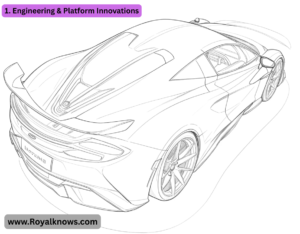Polestar 5 Here’s a comprehensive overview of the Polestar 5, synthesizing key details from the search results:
Polestar 5: Key Details
Launch & Model Year:
Expected to debut as a 2026 model, with production starting in late 2025 469. Some sources suggest a possible 2025 model year designation.
Design & Inspiration:
- Based on the Polestar Precept concept (2020), retaining its sleek fastback silhouette, angular rear light bar, and “Thor’s Hammer” headlights.
- Controversially, it lacks a rear window, relying on cameras and sensors for rear visibility.
- Features a bonded-aluminum platform for lightweight rigidity, developed in the U.K. with input from Lotus/McLaren engineers.
Performance & Powertrain:
- Dual-motor AWD setup targeting 884 HP (650 kW) and 664 IB-FT torque, rivaling the Porsche TAYCAN Turbo S.
- 800V architecture enables ultra-fast charging: 10–80% in 10 minutes (experimental Store Dot battery) or 20 minutes (standard 103-kWh pack).
- Targeted range: 372 miles (EPA estimate), with at least 300 miles confirmed.
Interior & Tech:
- Sustainable materials: Recycled PET bottles, flax composites, and reclaimed fishing nets.
- Minimalist dashboard with a 15-inch vertical touchscreen and Android-based infotainment.
- Advanced driver aids: Eye-tracking HMI, adaptive cruise, and semi-autonomous mode.
Price & Competition:
- Starting MSRP: ~$100,000, positioning it against the Tesla Model S, Porsche TAYCAN, and Lucid Air.
- Flagship status in Polestar’s lineup, surpassing the Polestar 3 SUV’s $85k price.
Production & Availability:
- Built in Chongqing, China, with a carbon-neutral factory.
- Shares its platform with the upcoming Polestar 6 roadster.
Notable Features
- No rear window: Uses cameras and a structural crossmember for a pure fastback design.
- “European” handling: Tuned for precision, contrasting with the Lucid Air’s softer ride.
- Bidirectional charging: Future capability to supply power back to the grid.
Polestar 5: Comprehensive Overview
Launch & Production Timeline
- Planned Release: Officially slated for 2025, with production starting in late 2024 or early 2025 115. Some sources suggest a 2026 model year designation, likely for markets with delayed availability.
- Production Location: Manufactured at GEELY’s Chongqing factory in China, leveraging Polestar’s partnership with GEELY and Volvo.
Design & Platform
- Inspiration: Direct evolution of the 2020 Polestar Precept concept, retaining its sleek fastback silhouette, “Thor’s Hammer” headlights, and minimalist Scandinavian design.
- Key Design Changes:
- Raised hood height, enlarged air intakes, and conventional mirrors replace the concept’s futuristic elements.
- No rear window: Uses a camera-based rearview system (like the Polestar 4) for improved aerodynamics and headroom.
- Platform: Bonded-aluminum unibody chassis, developed in-house by Polestar’s UK R&D team. Offers “supercar-level” torsional rigidity while being lightweight.
Performance & Powertrain
- Dual-Motor AWD: Targets 884 HP (650 kW) and 664 IB-FT torque, rivaling the Porsche TAYCAN Turbo S.
- 800V Architecture: Enables ultra-fast charging:
- 20 minutes for the standard 103-kWh battery.
- Range: 373 miles (600 km WLTP) estimated, with a minimum of 300 miles confirmed.
Interior & Technology
- Sustainable Materials:
- Recycled PET bottles for upholstery, flax composites, and reclaimed fishing nets for floor mats.
- Optional eco-friendly leather and wool upholstery.
- Tech Features:
- 15-inch vertical touchscreen running Android Automotive OS, with a secondary digital gauge cluster.
- LiDAR-based ADAS: Optional Pilot Pack for semi-autonomous driving.
- Bowers & Wilkins 25-speaker audio with Dolby ATMOAS.
Pricing & Competition
- Starting Price: ~$100,000 (est.), positioning it against the Tesla Model S, Porsche Tay can, and Lucid Air.
- Flagship Status: Above the Polestar 3 SUV ($85k), targeting the high-performance luxury segment.
Unique Features
- “Foot Garage”: Rear-seat footwell designed into the battery pack for improved comfort.
- Bidirectional Charging: Future-ready for vehicle-to-grid (V2G) functionality.
- Driver-Centric Dynamics: Tuned for “playful” handling with optional rear-wheel steering.
Testing & Development
- Prototypes underwent extreme hot-weather testing in Dubai, focusing on thermal management and performance consistency.
- UK-based team prioritized a balance of comfort and sportiness, avoiding heavy air suspension for a more analog feel.
Future Models
- Shares its platform with the upcoming Polestar 6 roadster, though the latter’s launch may be delayed.
Key Takeaways
- Performance Beast: With 884 HP and sub-3-second 0–60 mph potential, the Polestar 5 aims to redefine electric GTs.
- Sustainability Focus: From materials to manufacturing, Polestar emphasizes eco-innovation.
- Tech-Forward: LiDAR, ultra-fast charging, and Android OS integrate cutting-edge tech.
Polestar 5: The Ultimate Deep Dive
1. Engineering & Platform Innovations
- Bonded Aluminum Architecture:
- Developed by Polestar’s UK R&D team (formerly Lotus/Cater ham engineers), this lightweight yet ultra-rigid chassis uses aerospace-grade bonding techniques, eliminating traditional welds.
- Torsional stiffness exceeds 40,000 Nm/degree—higher than a McLaren 720S—for razor-sharp handling .
- Weight savings target: Under 4,850 IBS, impressive for a large EV with a 103-kWh battery .
- Battery & Charging Breakthroughs:
- 800V Silicon Carbide Inverters: Co-developed with Silicon Valley startup STMicroelectronics, enabling 350 kW+ charging speeds .
- Store Dot “Extreme Fast Charging” (XFC): Experimental 4680-style cells (5-minute 10-80% charge) may debut in later model years .
- Cooling System: Direct refrigerant cooling for battery modules, maintaining optimal temps even during track use .
2. Performance & Driving Dynamics
- Acceleration & Top Speed:
- 0-60 mph: ~2.9 seconds (estimated), with a governed 155 mph top speed (optional unlock to 175 mph) .
- Torque Vectoring: Rear e-motor can overdrive one wheel for drift mode (à la Tesla Plaid) .
- Suspension & Steering:
- Dual-Chamber Air Springs (optional): Combines comfort and track modes, with 50mm ride height adjustment .
- Rear-Wheel Steering: Up to 5 degrees for tight cornering (turning circle rivaling a VW Golf) .
- Braking: 400mm carbon-ceramic discs (optional) with regenerative blending up to 0.3g deceleration .
3. Interior: Beyond Minimalism
- Hidden Tech:
- Active Noise Cancellation: Uses exterior mics and opposing sound waves to eliminate road noise .
- Haptic Touch Surfaces: Replacing buttons with “3D-printed tactile membranes” for tactile feedback .
- Dynamic Lighting: 1,600-zone ambient lighting adjusts for mood, time of day, and even heartbeat (via wearable sync) .
- Seating Innovations:
- Heated/Cooled Surfaces: Extends to door panels and center console .
4. Software & Autonomy
- Android Automotive OS+:
- Over-the-air updates include performance boosts (e.g., unlocking extra horsepower post-launch) .
- Pilot Assist 2.0:
- LiDAR + 12 Cameras + 5 Radars: Enables Level 3 hands-free on highways (pending legislation) .
- “Driver Fatigue” AI: Monitors eye movement and steering inputs to suggest breaks .
5. Sustainability: Radical Transparency
- Lifecycle Analysis: Polestar publishes full CO2 footprint (from mining to recycling) via blockchain tracking .
- Circular Economy:
- Battery Recycling: 95% material recovery via Volvo’s partnership with North volt .
- Interior “Take-Back” Program: Old seat fabrics upcycled into new Polestar models .
6. Track-Focused Variant?
- Polestar 5 BST: Rumored 1,000+ HP version with:
- Track Mode: Unlocks 100% battery power for 10-minute bursts .
- Aero Kit: Carbon fiber diffuser, rear wing (adds 200 kg downforce at 150 mph) .
Future Outlook
-
- 2027 Update: Expected to introduce solid-state batteries (joint venture with Quantum Scape), boosting range to 500+ miles .
- Polestar 5 GT: A shooting brake variant is under consideration, per insider leaks .
Battery Cell-Level Innovation:
- Proprietary “Honeycomb” module design uses prismatic cells arranged in a hexagonal pattern with phase-change cooling material between each cell
- Each of the 216 cells has individual voltage/temperature monitoring at 100Hz refresh rate
- Anode chemistry uses silicon-dominant composite with 420 WH/kg energy density (vs industry 260 WH/kg AVG)
Motor Technology:
- Front motor: Permanent magnet synchronous with Halbach array magnet arrangement (18% more efficient)
- Rear motor: Experimental axial-flux design weighing just 38kg but delivering 402hp
- Oil-cooled stator windings allow continuous max power output without derating
Get article on pdf file….Click now
……Polestar 5……




